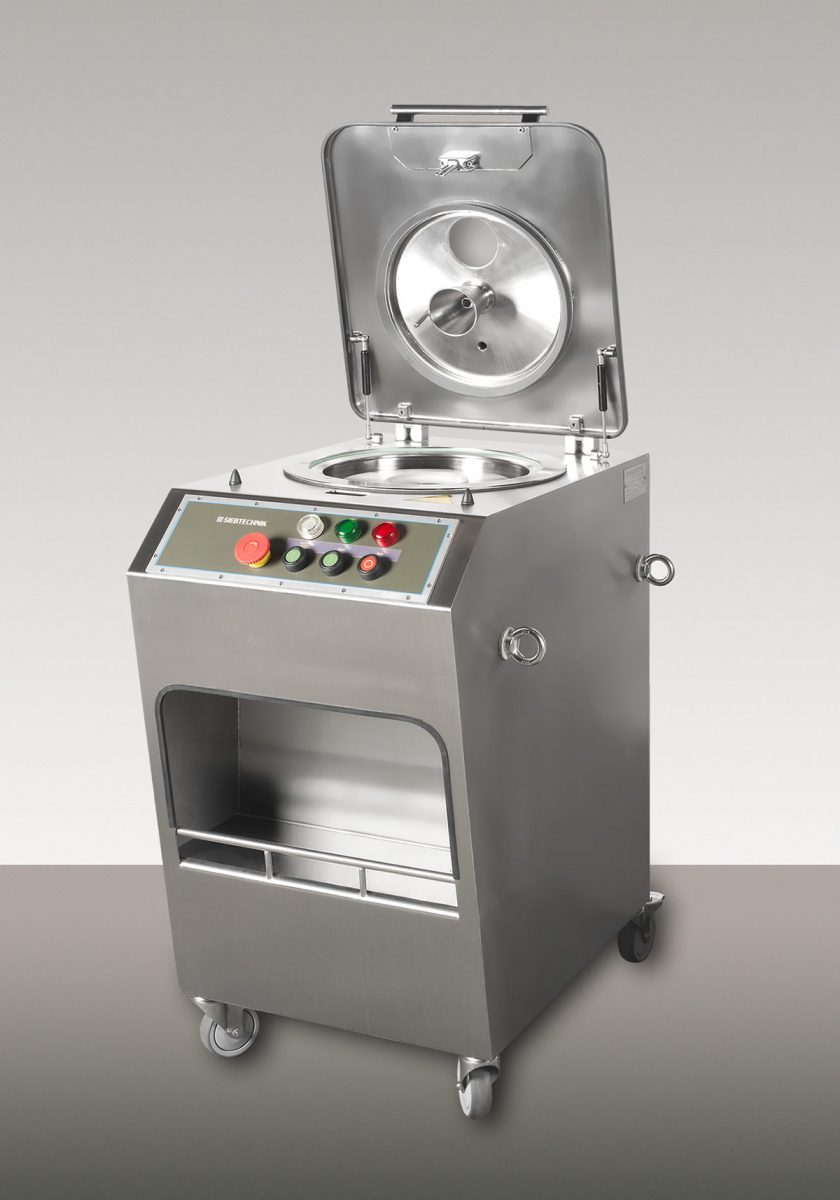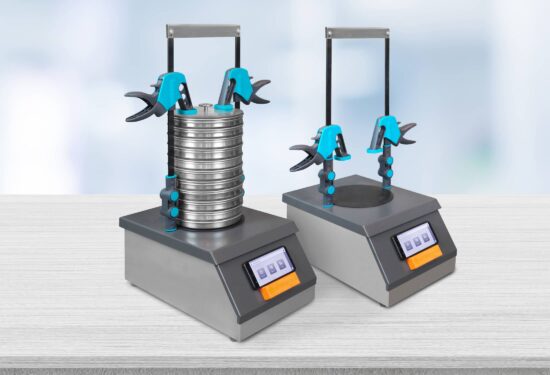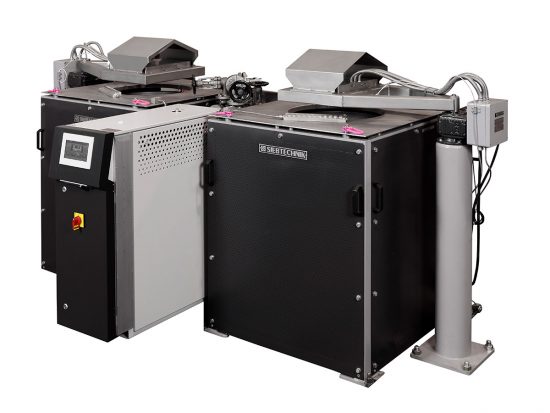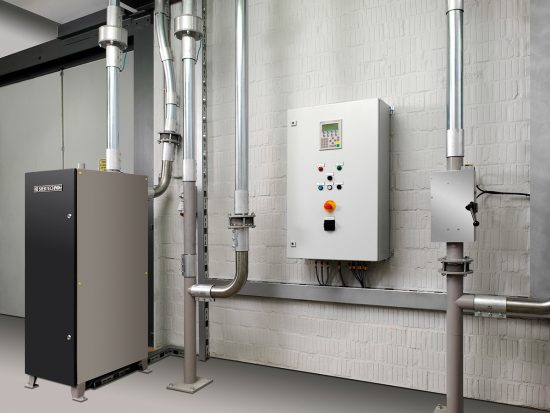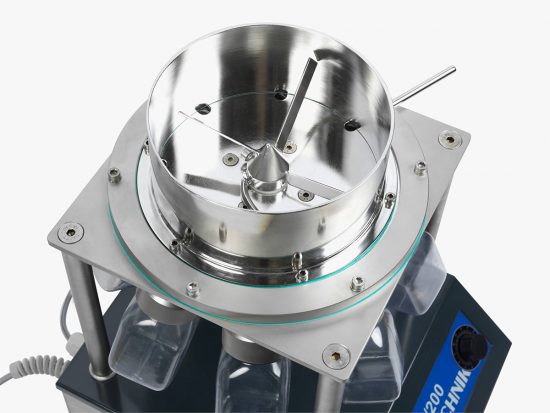Laboratory centrifuges
Laboratory centrifuges
High-performance centrifuges for the laboratory
For tests to laboratory standard and for the preparation of small quantities SIEBTECHNIK TEMA offers two different laboratory centrifuges.
CENTRIFLEX
The SIEBTECHNIK TEMA CENTRIFLEX centrifuge is a laboratory centrifuge with a wide range of applications.
The CENTRIFLEX can be used to test the separability of suspensions in the centrifugal field. Based on such laboratory tests the selection of a suitable centrifuge type as well as dimensional scaling of the centrifuge are possible. The CENTRIFLEX is characterized by very short start and stop times (few seconds depending on the selected g-force). With our laboratory centrifuge filtering and sedimenting centrifuges as well as continuous- or batch-centrifuges can be simulated by appropriate tests. For this purpose suitable beaker inserts are used in the centrifuge.
The CENTRIFLEX can also be used for many kinds of preparative work.
When fitted with the appropriate accessories, it can be used for filtration, washing, clarification, for continuous separation of two liquids and for the preparation of emulsions.
CENTRILAB
The CENTRILAB developed on the basis of the CENTRIFLEX laboratory centrifuge is used solely for testing the separability of suspensions in the centrifugal field. The choice of a suitable centrifuge type and dimensional scaling of a centrifuge are possible based on such laboratory tests. Practically every type of centrifugal can be tested and/or simulated very easily with the CENTRILAB, using a small quantity of material.
Operational behaviour and mechanical characteristics
CENTRIFLEX
The CENTRIFLEX has an extremely robust mechanical construction and a fully electronic control system. Practically every type of centrifugal separating apparatus can be easily tested and/or simulated with a small quanity of material. Essential operating parameters – g force, dwell time, cake thickness – can be precisely simulated in the test.
The CENTRIFLEX is accelerated to nominal speed in a very short time and braked to a standstill electrically. Here a slow run-down or a fast stop is possible. Automatic fast-stop enables precise centrifuging times to be achieved. Control of the centrifuge is by means of a easy-to-read touch screen control unit with digital display of speed, centrifuging time and operating status. Automatic timing or manual operation with time-keeping can be set.
The CENTRIFLEX is designed as a free-standung unit for operator-friendly setting-up and filling. The holding recess at the front of the housing offers a protected set-down place for receptacles for centrate and filtrate disposal.
Naturally the centrifuge is fitted with an electric cover interlock so that access to the rotating parts is possible only when the unit is at a standstill.
The fitting variants menu item denotes the the many possible means by which the CENTRIFLEX can be used in the laboratory and technical centre for the generation of smaller product quantities.
CENTRILAB
Acceleration and dwell times can be precisely preselected on a touch screen to the nearest tenth of a second. In order to avoid product swirls during analysis, the CENTRILAB is fitted with a specially developed soft-start-stop function.
The CENTRILAB is is designed as a portable table-top unit. Naturally the centrifuge is fitted with an electric cover interlock so that access to the rotating parts is possible only when the unit is at a standstill.
Fitting variants CENTRFLEX
With the appropriate accessories and in a few hand movements the CENTRIFLEX can be converted to the following variants:
Beaker centrifuge
For testing the sedimentation behaviour of suspensions or filtration behaviour of solids cakes. The centrifuge’s bottle holder holds 2 bottles or 4 bottles each with a capacity of 150 ml. Depending on the application, solid beakers or filter beakers are used.
The following filtering media can be inserted in the filter beakers:
- CONIDUR® slot-perforated plates
- Laser-perforated plates
- Slotted screen panels
- Filter paper
Beaker centrifuge (bottle centrifuge) with rotary feed system
If beakers are used, the centrifuge can be additionally fitted with a co-rotating feed system so that it can be filled while in operation. With the filtration beaker insert washing tests can also be conducted. Windows in the beaker sides and a special stroboscopic lamp (both optional) enable filtration and sedimentation processes to also be monitored and assessed visually.
Screen centrifuge with washing pipe
The screen centrifuge insert can be used for the separation of solids from liquids.
For this purpose the bowl is fitted with a wire mesh inlay and a filter bag (CONIDUR®, laser and slotted-screen inserts can also be used).
After ejection of the liquids the solids cake can also be washed and/or neutralised with the aid of a spray pipe.
Solid bowl centrifuge with overflow weir
or additionally with peeling tube. As a sedimentation centrifuge, this is used in many different ways to clarify liquids, particularly if the solid matter does not settle readily and requires longer centrifuging times.
The liquid rising to the surface can be discharged through a peeler tube after the solid matter has settled. Without the peeler tube the solid bowl can also be used as an overflow centrifuge for decanting liquids.
Service
Our reliable service enables optimum operation of your machines and systems. We offer energy optimisation, machine monitoring, an on-site maintenance and & repair service, OEM spare parts, damage cause analysis, maintenance & repair kits, stock inventory analysis, machine history management, personal technical consultation, training & workshops, 24 hr service, retrofitting & upgrades and used & loan machines.
Ask us, we’re there for you.
Advantages
CENTRIFLEX
- Multifunctional laboratory centrifuge
- High g force (6,000 g)
- Extremely short start/stop times
CENTRILAB
- Portable design
- High g force (3,500 g)
- Extremely short start/stop times
Downloads
CentrifugesSIEBTECHNIK TEMA - One Solution. Worldwide.
Service Management Centrifuges
Sample Preparation in the Laboratory


